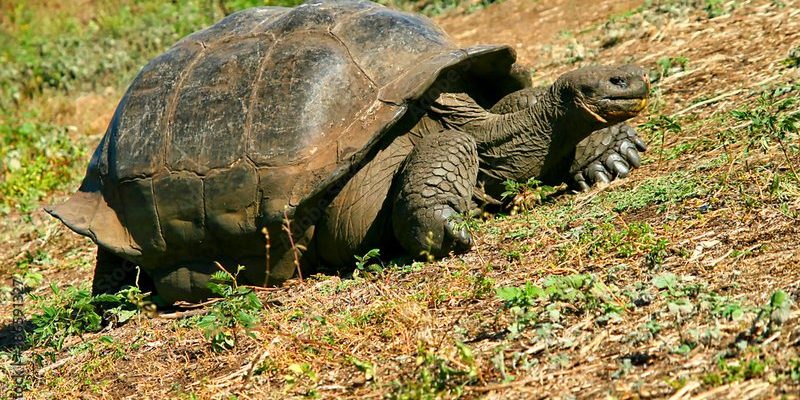![Galã¡Pagos Tortoise Vs. [Similar Species] - How They Compare](https://gudri.com/wp-content/uploads/2025/06/Gal__Pagos_Tortoise_Vs___Similar_Species____How_They_Compare_image_0.jpg)
Where They Call Home
Both the Galápagos tortoise and the Aldabra tortoise thrive on islands, but their environments couldn’t be more different. The Galápagos tortoise makes its home on the rugged volcanic islands of the Galápagos, where they adapt to various habitats, from arid lowlands to moist highlands. The islands’ diverse ecosystems allow them to find food and shelter, like prickly pear cactus and grasses. You might even say they’ve carved out a lifestyle as unique as the islands themselves.
On the flip side, the Aldabra tortoise resides on Aldabra Atoll, the second-largest coral atoll in the world. This atoll boasts lush vegetation and a predominantly flat landscape. The tortoises here enjoy a climate rich in biodiversity, including mangroves, mangrove swamps, and even saltwater habitats. The Aldabra tortoise has evolved to find its meals in this abundant environment, munching on grasses and leaves, quite different from its Galápagos cousin.
Physical Characteristics
You might be wondering how to tell these two tortoises apart at a glance. Well, size is a significant giveaway. The Galápagos tortoise is one of the largest tortoise species in the world, reaching weights of up to 600 pounds and lengths of about 6 feet. Their shells are domed and can vary in shape depending on the island they inhabit. Picture a giant, slow-moving tank, and you’ll get the idea!
In contrast, the Aldabra tortoise is slightly smaller, typically weighing between 300 to 550 pounds and measuring around 4 feet in length. Their shells are also domed but tend to be flatter compared to Galápagos tortoises. If you’ve ever seen an Aldabra tortoise, you might think of a natural, oversized walking dome. The differences in their shells are adaptations to their environments—helping them access food in different ways.
Diet and Feeding Habits
When it comes to food, both tortoises are herbivores, but their diets reflect their habitats’ unique offerings. The Galápagos tortoise enjoys a variety of plant material, ranging from grasses to cacti and even fruits. They have a special way of getting to their food, stretching their long necks to reach high branches. It’s like watching a giant turtle expertly navigate a buffet!
Meanwhile, the Aldabra tortoise has a diet rich in grasses, herbs, and leaves from shrubs and trees. They’re known to graze on your typical tortoise fare, but they’ll also nibble on young coconut palms and other vegetation. Imagine them lounging on the lush greenery, munching away as if they’re enjoying a picnic in the park.
Behavior and Lifespan
Both the Galápagos and Aldabra tortoises have fascinating behaviors that highlight their adaptability. The Galápagos tortoise is known for its social nature, often seen in groups, especially during breeding season. They communicate with each other using subtle body language and vocalizations, creating a sense of community on the islands.
On the other hand, the Aldabra tortoise tends to be more solitary. They are often seen roaming around the atoll, grazing peacefully on their own. Despite this, Aldabra tortoises can also form temporary groups around abundant food sources, showing they can be social when the occasion calls for it.
When it comes to lifespan, both species are impressively long-lived. Galápagos tortoises can live over 100 years, some even reaching 177 years! Aldabra tortoises are not far behind, with lifespans that can also exceed 100 years. So, if you ever meet one, just remember—it’s got stories to tell!
Conservation Status
As much as we love these incredible creatures, both the Galápagos and Aldabra tortoises face their share of challenges. The Galápagos tortoise has made a remarkable recovery thanks to conservation efforts after being severely threatened by hunting and habitat loss in the past. Organizations have worked hard to protect their habitats and educate people about their importance.
In contrast, the Aldabra tortoise is less threatened but still faces some risks. The main concerns include habitat loss due to human activities and climate change. However, they benefit from living in a protected area—Aldabra Atoll is a UNESCO World Heritage site, helping to safeguard their future.
Unique Facts About Each Species
Let’s spice things up with some cool tidbits about these tortoises. Did you know that the Galápagos tortoise can actually absorb water through its skin? This adaptation helps them survive in their sometimes arid environment. They’re like nature’s little survival experts!
On the Aldabra side, these tortoises have been observed returning to the same spot year after year to nest. It’s like they have their little vacation spot they can’t resist! Their behavior shows a solid attachment to their home, making them all the more endearing.
Both species continue to fascinate scientists and wildlife lovers alike. Each tortoise embodies a tale of survival, and they offer us lessons on resilience.
Final Thoughts
In summary, both the Galápagos and Aldabra tortoises are remarkable creatures with unique characteristics shaped by their environments. While they share common traits as large, herbivorous tortoises, their differences in habitat, appearance, and behavior highlight the diversity within this ancient group. Understanding these distinctions helps us appreciate the delicate balance of nature and the importance of conservation efforts.
Next time you think of tortoises, remember these two giants and their incredible journeys. Whether they’re lounging under the sun or munching on greenery, they’re symbols of nature’s endurance and adaptability, showing us that every species has a role to play in our world.

